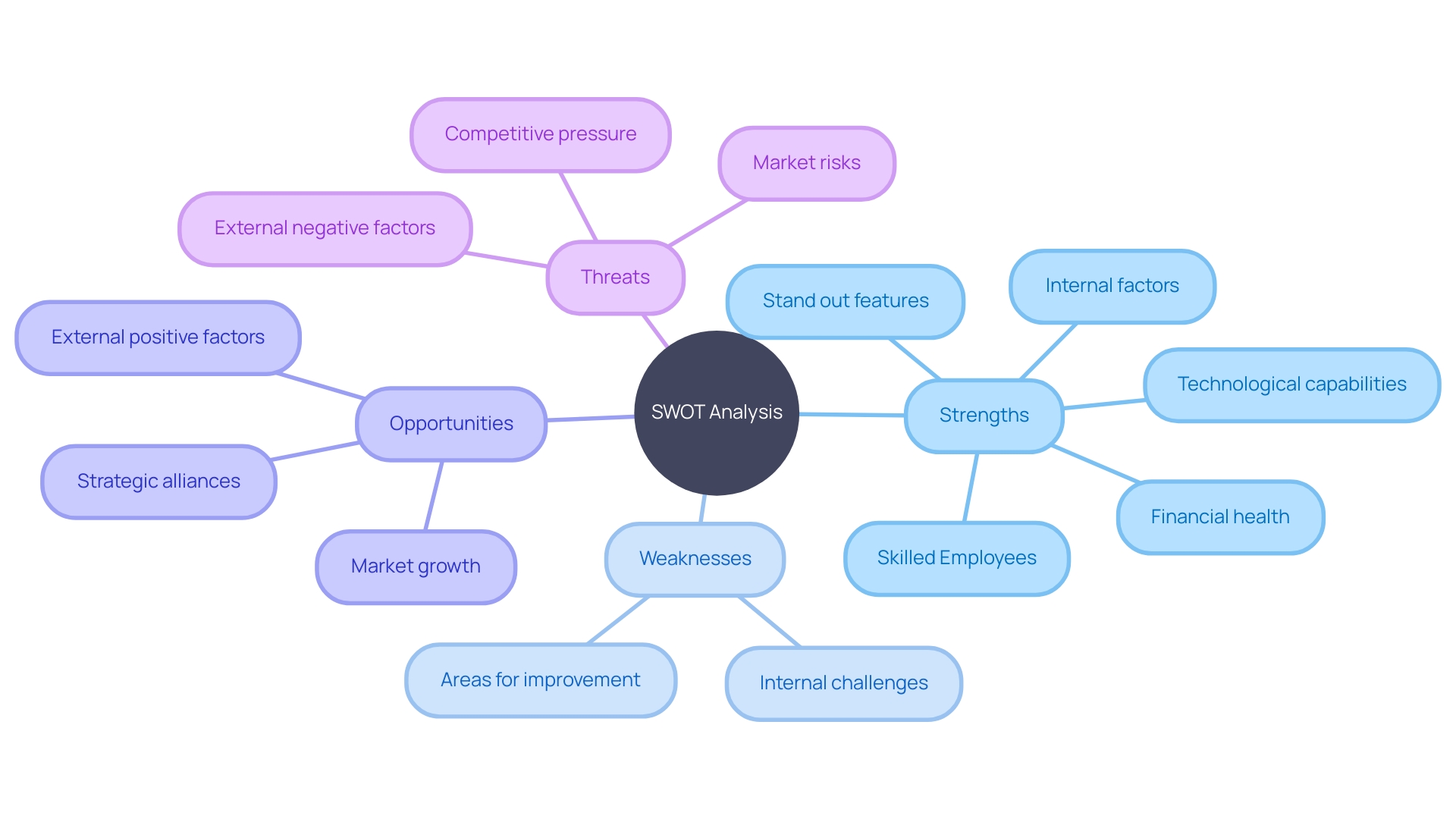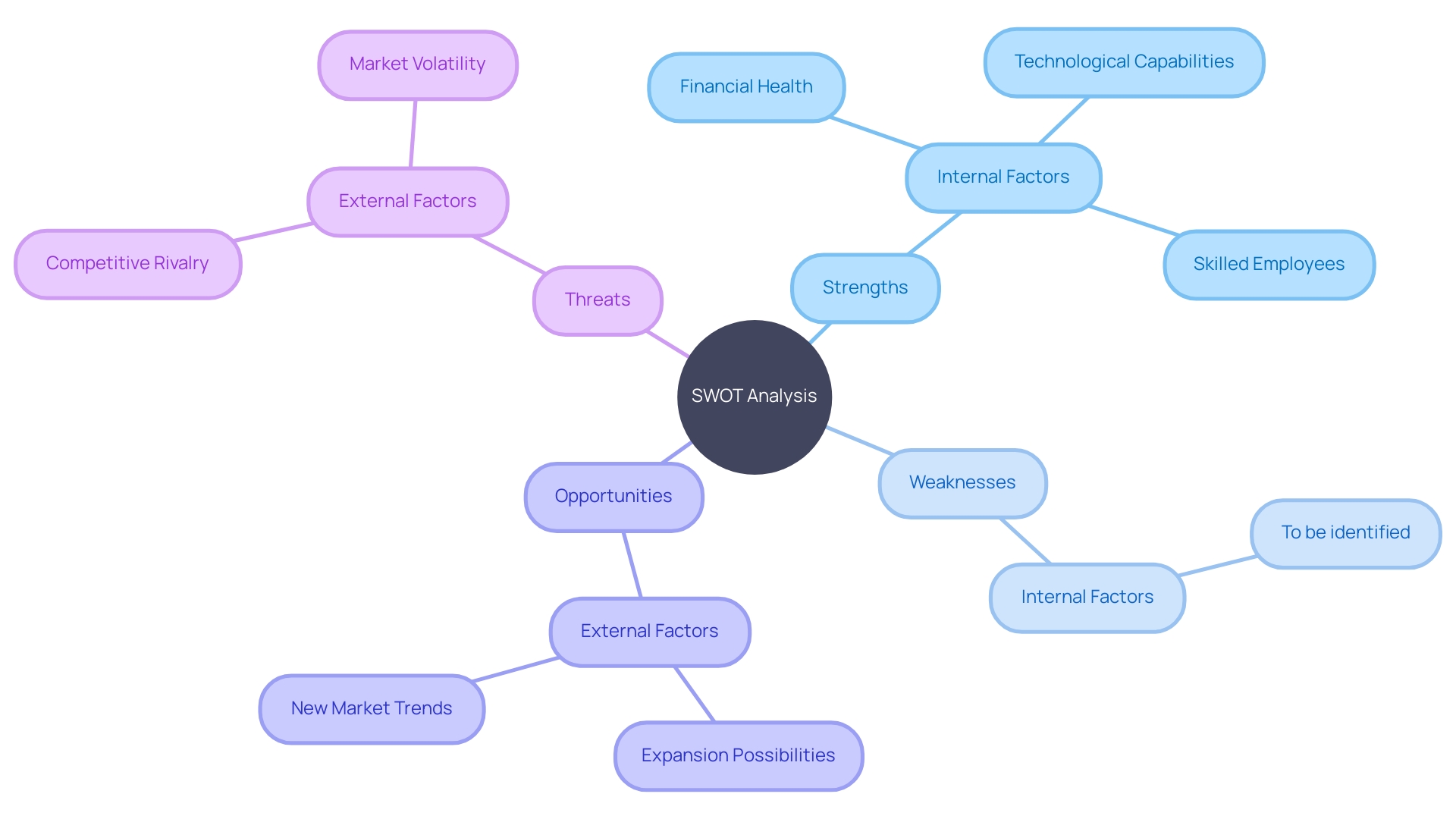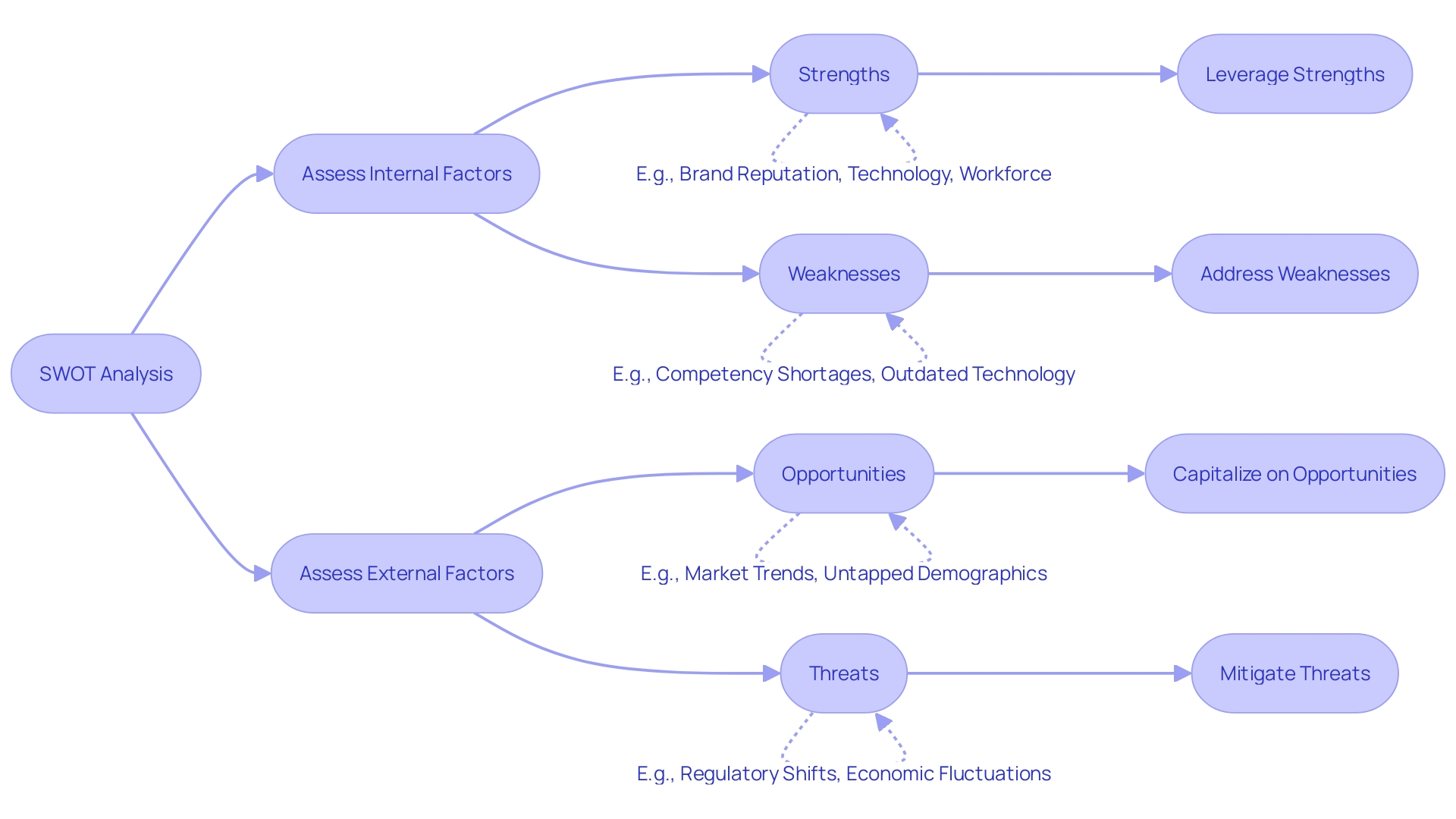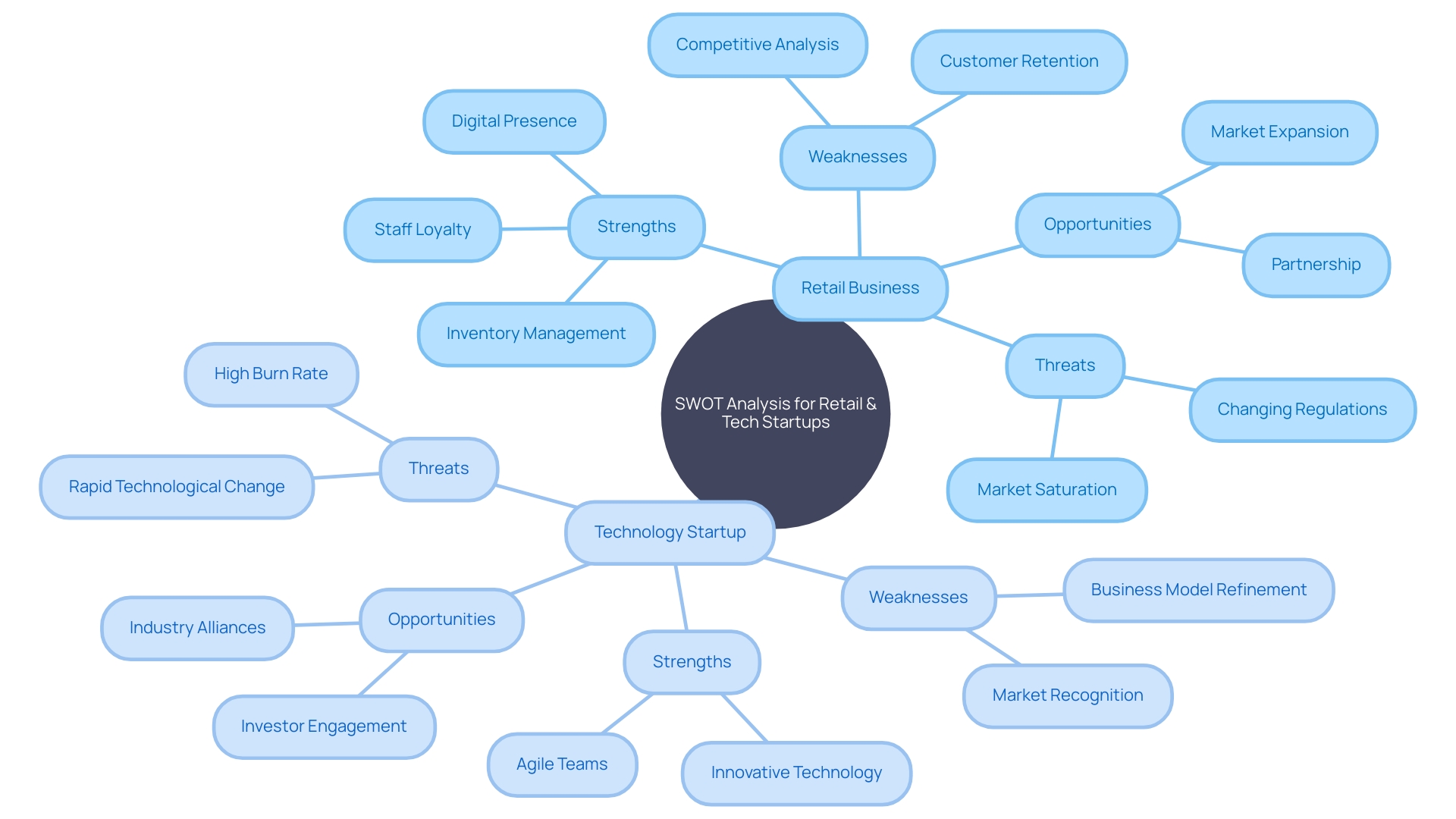Introduction
In today's competitive business landscape, organizations need to have a clear understanding of their internal strengths and weaknesses while staying alert to the ever-changing external factors. One strategic tool that enables this introspective examination is the SWOT Analysis. SWOT, an acronym for Strengths, Weaknesses, Opportunities, and Threats, helps businesses identify their unique qualities, areas for improvement, potential growth avenues, and possible challenges.
This practical article explores the importance of conducting a SWOT Analysis, provides a step-by-step guide on how to perform one effectively, and offers real-world examples of how this strategic planning tool can be applied across different industries. Whether you're a startup or an established enterprise, leveraging a SWOT Analysis can illuminate the path towards sustained success and market leadership in today's dynamic business environment.
What is a SWOT Analysis?
The utility of a SWOT Analysis transcends being just a strategic tool; it's a compelling framework for businesses to introspectively examine internal dynamics and vigilantly scan the horizon for external variables. Commonly known by its acronym, SWOT stands for Strengths, Weaknesses, Opportunities, and Threats. This quadrant-style analysis prompts organizations to lean into what they excel at—like standout traits or innovative technological prowess—and recognize areas ripe for improvement or indicative of a competitive lag.
Strengths are the unique qualities that give an enterprise its edge, perhaps signified by robust financials or a workforce renowned for excellence. Weaknesses, on the other hand, are the internal imperfections or gaps that may hinder progress or dilute effectiveness. Understanding these weaknesses is pivotal for crafting robust strategies to ameliorate them.
Looking outward, SWOT beckons a company to consider the external landscape—identifying Opportunities that align with their core competencies, and Threats that loom with potential to disrupt or cause harm. In the light of market volatilities or emerging technologies, these external factors are ever-changing, making it crucial for businesses to stay agile and responsive.
SWOT Analysis is an indispensable step in strategy development, merging objectives that anchor a company's aim with a strategy that charts the pathway forward. Development and planning are the supportive mechanisms ensuring the strategy remains dynamic and actionable—a synergy of direction and execution.
The relevance of SWOT Analysis is underscored by cases, such as, Siro's recognition at the 2023 European Broadband Awards, where their strategic positioning was integral to their acclaim. Regardless of scale—from nascent startups to mature enterprises—a well-executed SWOT can illuminate the path towards sustained success and market leadership, highlighting the importance of this strategic planning tool in interrogating the present to adeptly navigate the future.

Why Conduct a SWOT Analysis?
Leveraging a SWOT analysis allows businesses to outline their competitive edge by identifying the core attributes that distinguish them from rivals. This strategic tool is invaluable for unpacking an organization's unique strengths, pinpointing areas that need enhancement, recognizing potential for growth, and staying vigilant about possible challenges. It further enables companies to match their capabilities to the demands of the market, enhancing overall performance and guiding critical decision-making processes.
Strengths within a company may range from exceptional employee expertise to advanced technological infrastructure or robust financial health, each contributing significantly to market differentiation. Meanwhile, understanding weaknesses equips a business to focus on areas for improvement to fortify its market position. Identifying opportunities, such as untapped markets or innovative product ideas, can accelerate growth, while acknowledging threats — like burgeoning competition or supply chain vulnerabilities — enables proactive risk management.
A SWOT analysis, effectively applied, can illuminate the strategic trajectory for enterprises across industries. By thoroughly analyzing internal and external factors, organizations can devise strategies to leverage their inherent strengths, shore up weaknesses, seize opportunities, and guard against external threats. Whether it's exploring new markets or enhancing customer service standards, the insights derived from SWOT analysis serve as a blueprint for strategic advancement.

How to Conduct a SWOT Analysis
Executing an adept SWOT Analysis is fundamental in charting a strategic course for any business entity. It commences with pinpointing strengths such as robust brand recognition, a talented workforce, or efficient operational procedures—internal dynamics that proffer a competitive edge. In juxtaposition, weaknesses need scrutiny.
This evaluative lens spans from technological stagnation to resource scarcity, encompassing any aspect hindering performance.
Opportunities are external advantages poised for exploitation. Be it burgeoning markets, propitious industry trends, or synergistic partnerships, they present lucrative avenues for expansion. Conversely, an assessment of threats reveals potential adversities, from burgeoning competition to shifting regulatory landscapes or economic fluctuations.
The cultivation of strategic initiatives stems from this rigorous analysis. Businesses leverage strengths, navigate weaknesses, adapt to opportunities, and safeguard against threats. This comprehensive understanding fosters informed decision-making crucial for navigating the complex business milieu.
One salient instance of SWOT in action includes startups employing this tool for plotting their inaugural trajectory, ensuring a potent launch pad for future endeavors. Across the business spectrum, from governing entities to bottom-tier teams, SWOT enhances communication and converges collective focus, consolidating a panoramic view of operational impacts and long-term ramifications.
Statistics within the SWOT framework further enrich this planning matrix. It not only illuminates a company's distinct capabilities but also equips it with a strategic foresight—arms length yet graspable through an easily interpreted SWOT matrix. This visual synopsis encapsulates a business's calibration between its goals and real-world vicissitudes, propelling it towards judicious choices and strategic alacrity.
The quintessence of SWOT analysis rests in understanding your business's current state and envisaging its desired odyssey. It accentuates organizational particularities and navigates uncontrollable variables with aplomb, solidifying the foundation for tailoring strategy and operations adeptly.
Step-by-Step Guide to Creating a SWOT Analysis
Embarking on a SWOT Analysis requires more than just a thorough examination; it necessitates a strategic approach that comprehensively encompasses both the nuances of the company’s internal capabilities and the unpredictability of external circumstances. First, delve into understanding your organization's strengths by scrutinizing internal resources such as brand reputation, proprietary technology, and the proficiency of your workforce. Then shift your focus internally, putting under the microscope potential weaknesses in your operational framework.
This could span from a shortage of certain competencies to outdated technology or inadequate processes.
Subsequently, turn your attention outward to spot external opportunities that could catalyze growth. Emerging market trends, potential untapped customer demographics, and overall sector expansion present advantageous prospects for strategic endeavors. Similarly, evaluation of external threats is crucial.
The exercise is not limited to perceiving the current landscape but also entails forecasting future hurdles such as regulatory shifts, economic fluctuations, or intensifying competitive pressure.
With a critical eye, sift through the gathered insights to distill the elements that bear the most significance, subsequently ranking them in order of impact on the enterprise. Once the analysis is synthesized, wield this intelligence to formulate strategic actions that not only bolster your company’s strong suits and bridge gaps but also capitalize on market openings and fortify against potential external complications.
It’s imperative not to view the SWOT analysis as a one-off event but as a dynamic component of your strategic arsenal, regularly revisiting and revising it to stay abreast of both internal changes and shifts in the business environment.
By incorporating the overarching perspectives from case studies, news, and expert quotes surrounding the critical aspects of SWOT analysis—from understanding business plans to acknowledging the vital role of informed decision-making—your strategy will be underpinned by an informed, systematic approach buoyed by real-world applications and empirical data.

Practical Examples of SWOT Analysis
Let's delve into practical scenarios where SWOT analysis illuminates strategic choices:
- Retail Business
- Strengths: Proven customer base, strategic store positioning, robust supplier network.
- Weaknesses: Underdeveloped e-commerce, antiquated inventory systems, volatile staff turnover.
- Opportunities: Burgeoning online shopping trend, untapped demographics, niche product interest.
- Threats: Aggressive digital rivals, mutable consumer tastes, economic downturns.
Dissecting these elements, the retailer might strategize to enhance its digital footprint, modernize inventory management, and foster staff loyalty.
- Technology Startup
- Strengths: Forward-thinking product, expert development crew, substantial investor backing.
- Weaknesses: Diminished market visibility, unscaled business architecture, lofty customer acquisition expenses.
- Opportunities: Surging product demand, potential key partnerships, nascent market shifts.
- Threats: Swift tech innovation, fierce industry rivalry, funding vicissitudes.
Taking stock of these aspects, the startup could concentrate on elevating market recognition, refining their business model, and seeking industry alliances.
These exemplars underscore how SWOT Analysis aids entities in comprehending their distinctive contexts and forming tactics to enhance strengths, counterbalance weaknesses, capitalize on opportunities, and stave off threats.

Conclusion
In conclusion, conducting a SWOT Analysis is crucial for businesses to understand their strengths, weaknesses, opportunities, and threats. This strategic tool helps organizations leverage their competitive edge, address areas for improvement, explore growth avenues, and manage challenges. By examining internal dynamics and scanning the external landscape, businesses can create a roadmap for sustained success.
To perform a SWOT Analysis effectively, identify strengths like robust financials and standout traits, and recognize weaknesses that hinder progress. Consider external factors like market volatilities and emerging technologies to identify opportunities that align with core competencies. Analyze threats that could disrupt operations.
Formulate strategic actions that leverage strengths, address weaknesses, capitalize on opportunities, and fortify against potential external complications.
The SWOT Analysis process involves pinpointing strengths, scrutinizing weaknesses, assessing opportunities, and analyzing threats. Regularly revisit and revise the SWOT Analysis to stay updated with changes in the business environment. Adapt the analysis to guide decision-making and support strategic advancement.
Practical examples highlight how SWOT Analysis aids businesses in making informed choices. Whether enhancing digital presence or elevating market recognition, it helps organizations comprehend their unique contexts and develop tailored strategies.
In summary, a SWOT Analysis is a powerful tool for businesses to gain insights into their internal dynamics and external environment. By leveraging this strategic framework, organizations can pave the way towards sustained success and market leadership. It guides decision-making and supports strategic advancement in today's dynamic business landscape.




